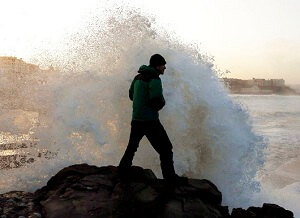Storm Weather Warnings by the Met Office
It’s not uncommon to get storm weather warnings at certain times of the year in the United Kingdom.
The waves and winds can be extremely unpredictable and they get upgraded and downgraded on a regular basis.
So, HM Coastguard are urging people to stay on safety alert any time they make a visit to the British coastlines.
Onshore and offshore winds can still be very strong and blustery in Britain – even when the Meteorological Office downgrades them.
Furthermore, the combination of big tidal swells, large unpredictable waves, and gusting winds can often catch people off guard. Hence, the risk of danger from waves and wind lingers.
Here’s a summary of the waves and wind safety tips issued by HM Coastguard. Their advice is to keep well away from breaking waves, jetties, and piers and to stay well back from cliff edges.
5 Tips for Staying Safe in Wind and Waves
1. Avoid Taking Selfies in Dangerous Areas
For many, the temptation for taking ‘selfies’ in adverse weather conditions is far too strong. But, doing so can be a real danger to life.
So, stay away from harbour walls, groynes (low walls or sturdy barriers), piers, and jetties when the weather is windy. You’re too close if you can feel the spray… and a large wave can sweep you away in an instant!
Note: The ‘selfie’ has become one of the hottest trends, especially on social media. So, what are the guidelines for taking selfies – with and without makeup?
2. Wave Dodging is Not a Safe Sport
Playing ‘dares’ with waves (also called wave dodging) is dangerous even when Britain’s weather is pleasant and predictable.
Most of the rocks and walls are unstable and slippery. Often, you would have nothing to grab hold of if you get caught off balance.
Thus, a rogue wave or strong current could sweep you out to sea in a matter of seconds.
Note: We have a section listing dozens of weird extreme sports if that’s what floats your boat.
3. Take Extra Care with Dogs
 Walking with a dog at the cliffs and coasts is a popular way to spend some time in the fresh air. But, you should always keep dogs on a lead and close by. After all, a curious ‘sniff’ from another canine could spell disaster.
Walking with a dog at the cliffs and coasts is a popular way to spend some time in the fresh air. But, you should always keep dogs on a lead and close by. After all, a curious ‘sniff’ from another canine could spell disaster.
You should contact the coastguard for assistance if your dog gets trapped or needs rescuing. They have teams trained in making fast responses in challenging terrains.
Note: The section on dog welfare contains useful tips and advice for anyone taking care of dogs or puppies.
4. Be Cautious Near Cliff Faces
Staying a sensible distance away from the edges will help you avoid any cliff crises. Windy conditions increase the risk of getting caught off balance – particularly for small children.
Fact: Landslides and rock falls are common during and after bad weather.
5. It’s Smart to Keep in Touch
- Always tell a responsible person where you are going and when you expect to return.
- Keeping a note of local tide times will help you avoid getting trapped.
- Having a fully charged mobile phone means you can summon assistance if things turn bad (with a ‘find me’ app is best).
Important: Call 999 without delay and ask for the coastguard if you or anyone is in trouble on the coast. You can also report a marine accident by calling the MAIB reporting line on [+44 (0)23 8023 2527].

